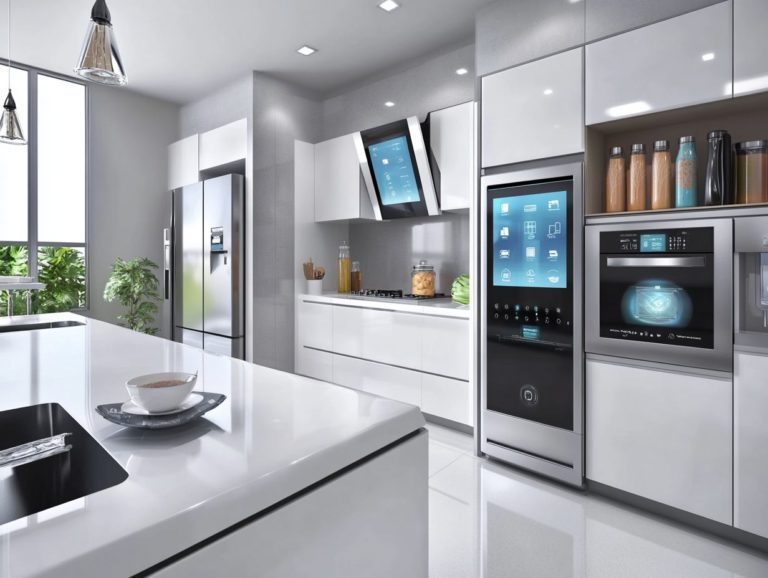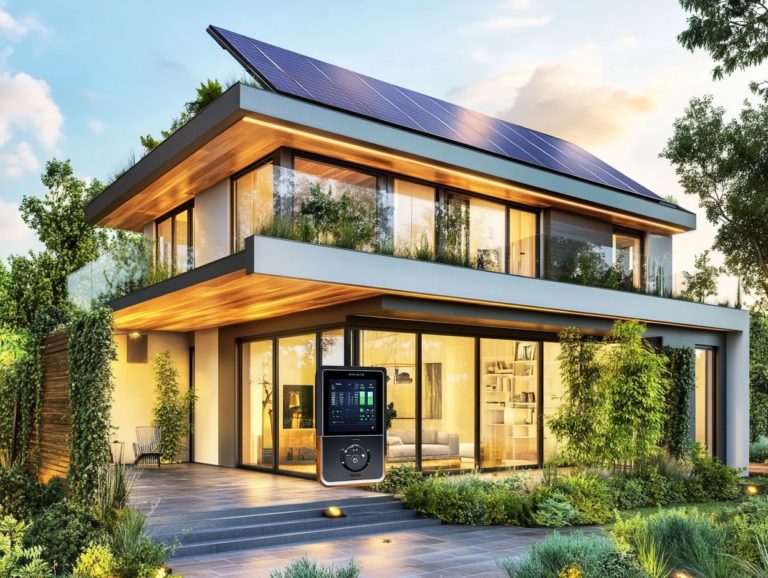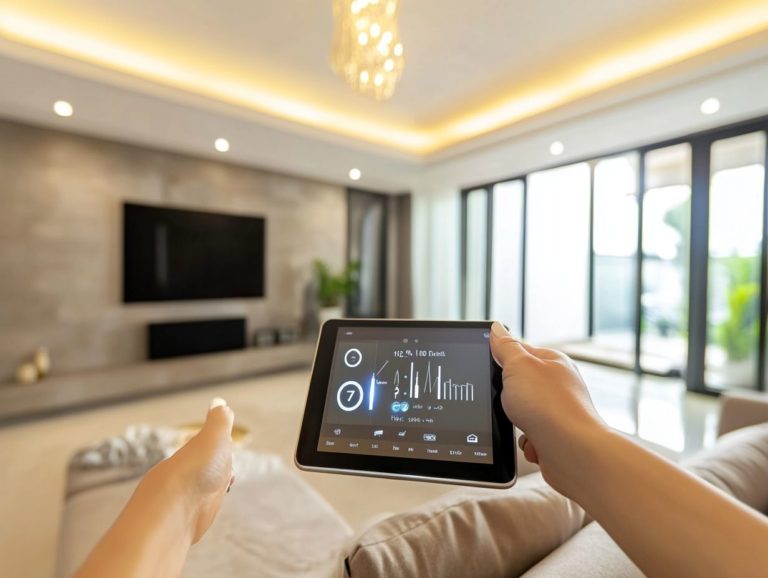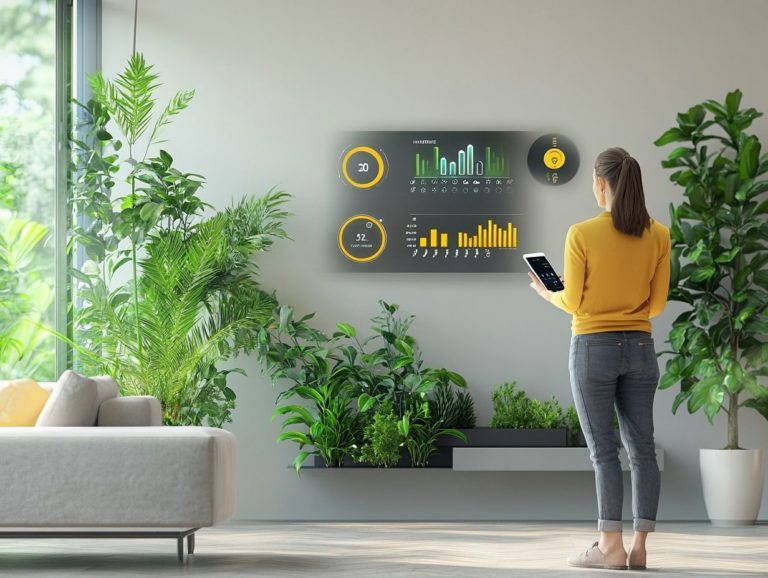Best Practices for Smart Home Energy Management
Smart Home Energy Management is transforming the way you consume and manage energy in your residence through advanced energy systems.
With the relentless march of technology, you now have access to innovative solutions that can help you cut costs while reducing your environmental footprint. This article delves into the numerous benefits of adopting smart energy solutions, ranging from smart thermostats to intelligent lighting systems.
It offers best practices for optimizing energy efficiency and assists you in selecting the perfect smart home system tailored to your home.
Even the simplest changes can pave the way for substantial savings and a more sustainable lifestyle, particularly with smart lighting and energy monitoring.
Contents
- Key Takeaways:
- Benefits of Implementing Smart Home Energy Management
- Key Components of Smart Home Energy Management
- Best Practices for Optimizing Energy Efficiency
- Choosing the Right Smart Home Energy Management System
- Frequently Asked Questions
- What are the best practices for smart home energy management?
- How can I make my smart home energy management more efficient?
- Are there any safety precautions I should take when using smart home energy management?
- Can smart home energy management help me save money?
- How do I get started with smart home energy management?
- Can smart home energy management benefit the environment?
Key Takeaways:
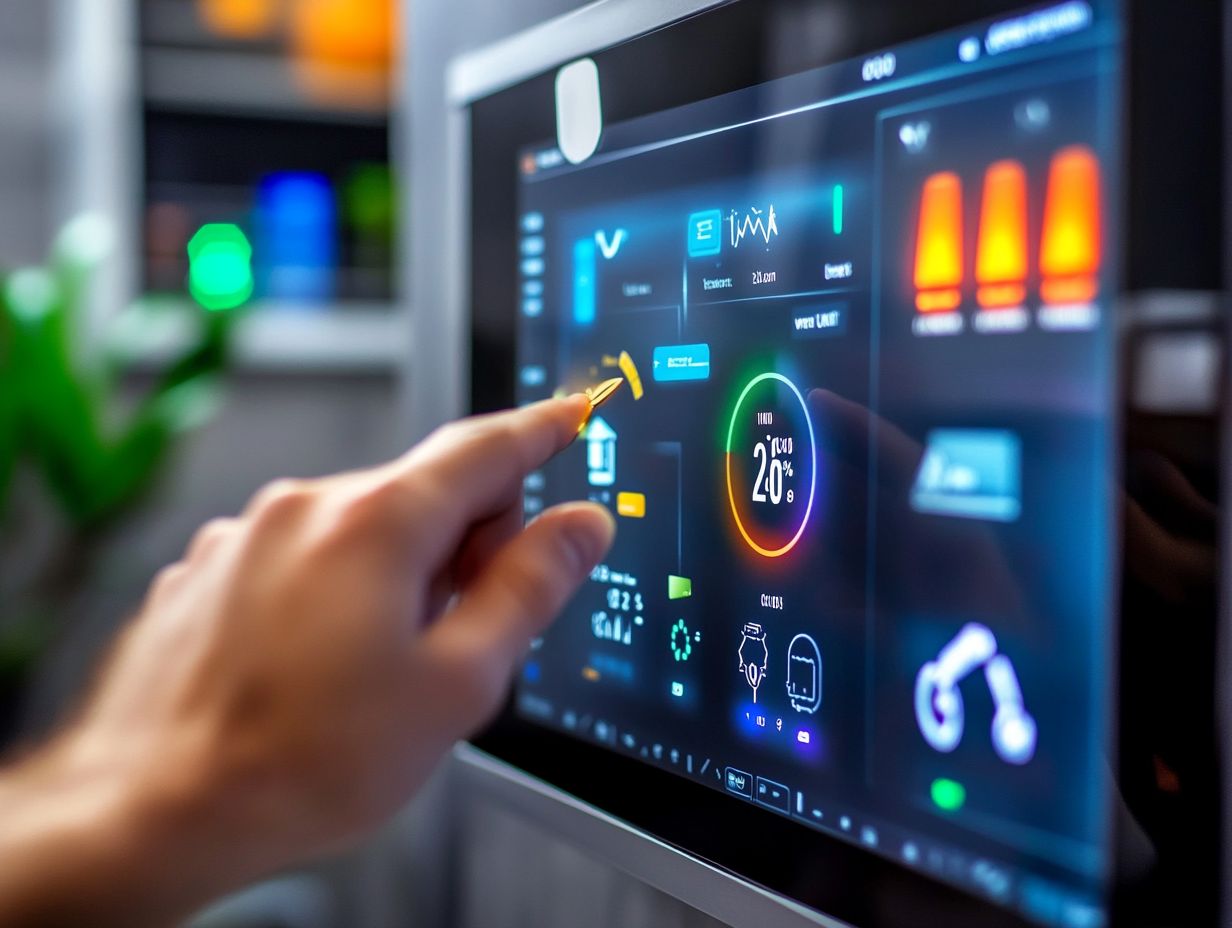
- Smart home energy management can save you money and reduce your environmental impact.
- Key components such as smart thermostats, lighting, and plugs/strips are essential for optimizing energy efficiency.
- Track energy usage for better savings.
What is Smart Home Energy Management?
Smart Home Energy Management represents a transformative shift in how you can monitor, control, and optimize your home s energy consumption. With the integration of smart energy systems, you can utilize smart devices and home automation technologies to gain valuable insights into your energy usage patterns. This knowledge gives you the power to make informed decisions that enhance energy efficiency and help lower your energy costs.
This approach includes various energy sources, such as solar power and electric vehicles, offering a holistic solution for modern households eager to minimize their energy footprint.
The importance of smart home energy management is clear: it enables you to track your consumption in real-time and adjust settings remotely, aligning with your lifestyle and preferences. By incorporating smart thermostats, energy-efficient lighting, and intelligent appliances, you can tap into the potential for substantial waste reduction.
Many of these systems come equipped with data analysis tools that provide tailored recommendations for further optimizing your usage, ultimately promoting a culture of sustainability.
By embracing these technologies, you re not merely saving money; you re also playing a crucial role in fostering a more sustainable future by decreasing overall energy demand and reliance on non-renewable energy sources.
Benefits of Implementing Smart Home Energy Management
Smart Home Energy Management offers amazing benefits more than just energy savings! Implementing it can profoundly influence both the financial and environmental health of your household.
As a homeowner, you gain greater control over your energy usage, resulting in lower energy costs while also playing your part in reducing carbon emissions.
This forward-thinking approach enables you to monitor your energy consumption more effectively and seamlessly integrate renewable energy solutions, like solar panels. Ultimately, it cultivates a more sustainable living environment that aligns with your values and enhances your quality of life through smart home technology.
Cost Savings and Environmental Impact
The cost savings you can achieve through Smart Home Energy Management are truly impressive. Optimizing your energy usage directly leads to lower energy bills while championing environmental sustainability by reducing your reliance on non-renewable energy sources.
By taking advantage of dynamic tariffs varying prices for energy based on demand and integrating renewable energy solutions like solar panels, you cut down on your overall energy costs and positively impact the environment by lowering carbon emissions.
Using advanced monitoring tools gives you real insights into your energy use, empowering you to make informed decisions that further reduce waste. This dual advantage of saving money while protecting natural resources aligns seamlessly with modern sustainability goals.
As you embrace smart technologies like energy-efficient appliances, smart thermostats, and smart plugs, you’re not just trimming your expenses; you’re also sparking a ripple effect that encourages environmentally friendly practices in your community, especially through how smart home technology enhances energy efficiency.
Ultimately, this synergistic approach shows that energy management is not just a financial strategy; it s a pathway to a greener tomorrow with the help of smart home systems. Don t wait! Start saving money and protecting the environment today!
Key Components of Smart Home Energy Management
Key components of Smart Home Energy Management encompass a range of cutting-edge technologies and devices that meticulously optimize energy usage, such as smart sensors and systems that help manage energy use, enabling you to conserve energy while enhancing overall efficiency in your home.
These devices include smart thermostats, advanced lighting solutions, smart plugs, energy monitoring systems, and smart water sensors. They collaborate seamlessly to offer you valuable insights and control over your energy consumption.
This not only gives you the power to adopt a more sustainable lifestyle but also promotes a cost-effective approach to managing your energy needs with energy contracts.
Smart Thermostats

Smart thermostats are essential for effective energy management, allowing you to optimize your heating system and enhance energy efficiency with automated scheduling and real-time adjustments. These devices learn your preferences and adapt to environmental changes, ensuring your comfort while significantly contributing to energy savings.
This technology minimizes energy waste by intuitively adjusting settings according to your occupancy patterns and specific needs, ultimately leading to reduced utility bills. Many smart thermostats come with features like remote access through smartphone apps, enabling you to monitor and control your home environment from anywhere. This not only adds a layer of convenience but also gives you the power to make informed decisions about your energy usage.
By integrating such a device, you can embrace a more sustainable and cost-effective lifestyle, benefiting both yourself and the environment.
Smart Lighting
Smart lighting solutions are revolutionizing how you manage energy consumption in your home. With adjustable brightness and color settings accessible through home automation systems, these innovative devices elevate the ambiance and enhance energy efficiency. You can effortlessly reduce unnecessary energy use, ensuring that your lights are only on when truly needed.
This functionality allows you to personalize your lighting to suit your daily activities whether you require vibrant illumination for daytime energy or a warm, soft glow for evening relaxation. Many of these systems can even be programmed to turn off automatically when a room is unoccupied, further cutting down on energy waste.
Smart lighting easily connects with other smart home devices, fostering a cohesive and energy-efficient environment. By employing LED technology, these solutions consume significantly less electricity compared to traditional bulbs, resulting in lower utility bills and a reduced carbon footprint. For a deeper understanding of how to enhance your home, explore the energy-efficient smart home design principles that perfectly align with your sustainability goals.
Smart Plugs and Power Strips
Smart plugs and power strips are essential tools in your journey to automate energy use. They allow you to monitor and control the energy consumption of connected devices from a single, centralized platform. This control helps you track your energy usage patterns and significantly reduces waste, leading to impressive energy savings over time.
These devices often come equipped with scheduling features. You can set precise timers so that appliances are powered on only when necessary, effortlessly preventing unnecessary electricity expenditure.
Many smart plugs and power strips are designed to be compatible with your home automation systems. This ensures seamless integration into your existing smart home setup, allowing you to implement various scenarios easily, such as turning off all devices with a single command when you leave home.
Additionally, real-time monitoring capabilities through energy management solutions mean you can see energy usage as it happens. This gives you the power to identify major energy consumers, enabling you to make informed choices that help create a greener future.
Best Practices for Optimizing Energy Efficiency
Optimizing energy efficiency in your smart home calls for a strategic approach that integrates a range of best practices. By leveraging energy management solutions and advanced smart technology, you can maximize your energy savings.
Implementing effective schedules, using smart devices, and continuously monitoring your energy usage significantly reduces your energy footprint while enhancing overall efficiency. It’s a smart way to not only save money but also explore 5 smart energy solutions for modern homes that can help create a greener future.
Creating Schedules and Automating Systems
Creating schedules and automating systems are key strategies for maximizing energy efficiency in your smart home. By optimizing the operation of your energy-consuming devices, you ensure that energy is used only when necessary. Establishing routines for devices like smart thermostats and smart lighting allows you to achieve substantial energy savings.
These practices lead to lower utility bills and enhance your overall comfort by maintaining ideal temperatures and ambient lighting. For instance, integrating motion sensors can automatically turn off lights in unoccupied rooms, cutting down on unnecessary energy consumption and contributing to overall energy savings.
You can also schedule major appliances, such as washing machines or dishwashers, to run during off-peak hours, taking advantage of lower energy prices. By utilizing automation, especially energy automation tools, you create an energy-efficient ecosystem that seamlessly aligns with your daily life, resulting in both economic and environmental benefits.
Monitoring and Adjusting Energy Usage
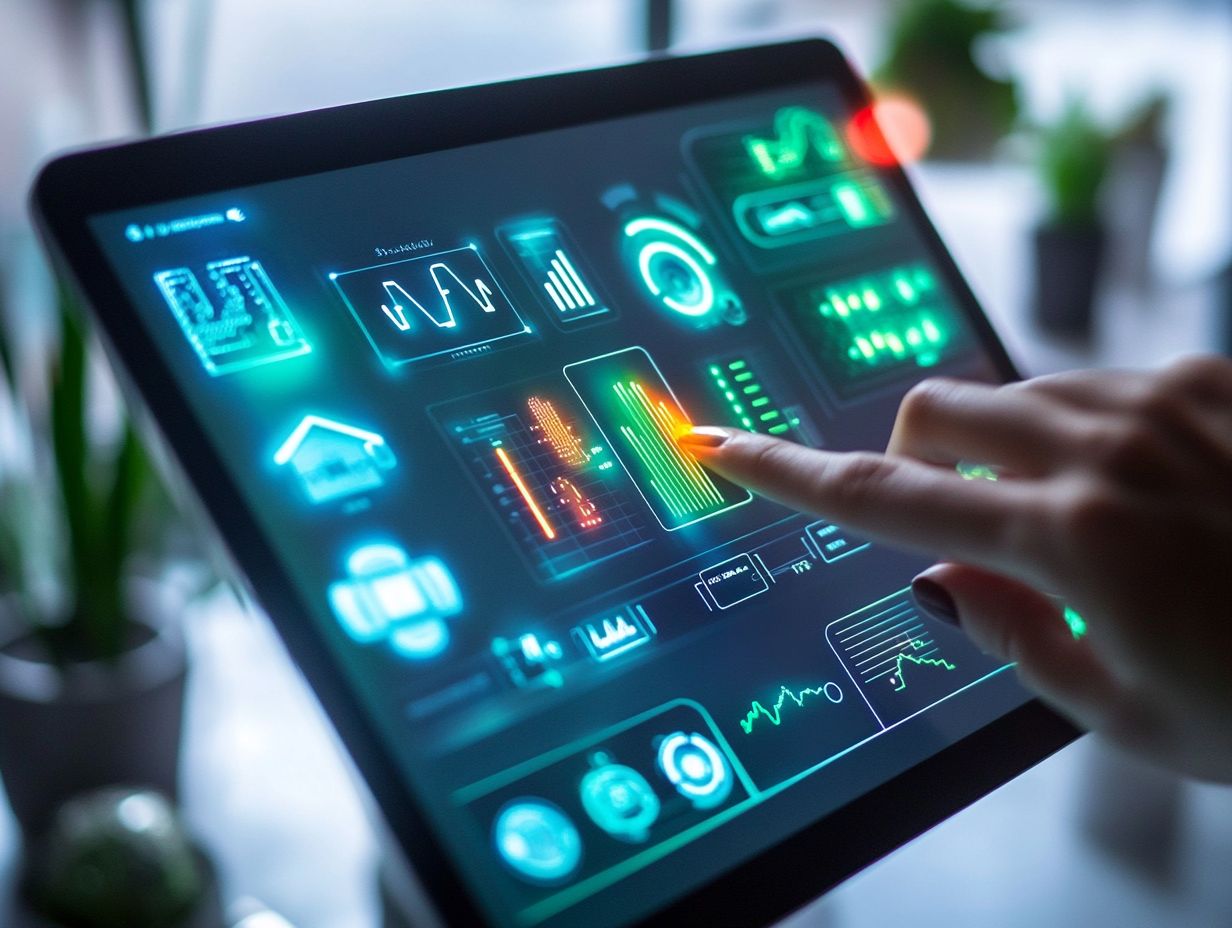
Take charge of your energy usage for optimal energy efficiency in your smart home. This proactive approach provides valuable insights into your consumption patterns, allowing you to pinpoint areas that could use improvement.
As a result, you can make necessary adjustments to your energy management strategies, leading to enhanced savings and a reduced environmental impact.
Embracing a variety of advanced tools and techniques can elevate this process even further. Smart meters and energy monitoring systems provide real-time data, enabling you to track your usage throughout the day.
Mobile applications can analyze your consumption trends, alerting you to spikes in energy use or suggesting more efficient alternatives. By implementing automated solutions like programmable thermostats, smart appliances, and smart plugs, you can ensure that energy is consumed only when necessary. For more tips, check out this guide on how to choose energy-efficient smart devices.
This not only guides you toward a more sustainable lifestyle but also optimizes your overall energy costs. Start maximizing your energy savings today!
Choosing the Right Smart Home Energy Management System
Selecting the ideal Smart Home Energy Management System (HEMS) which may include tools from brands like Honeywell or Siemens is pivotal for homeowners aiming to optimize energy usage while seamlessly integrating intelligent devices and efficient management solutions.
With a plethora of options at your fingertips, including energy management systems that utilize renewable energy sources like solar panels, a thoughtful and informed selection process will guarantee that the system you choose aligns perfectly with your unique needs and energy consumption habits.
Overall aspirations for enhanced energy efficiency must also be considered.
Key Factors for Choosing Your Smart Home System
When you re choosing a smart home energy management system, focus on energy monitoring capabilities, ease of integration with your existing smart home systems, and features that enhance energy efficiency. Each of these components plays a vital role in crafting an effective energy management strategy.
The ability to grow with your needs is another crucial aspect. You’ll want to expand your smart home ecosystem with additional smart devices as your needs evolve over time. Exploring top smart home security devices that save energy can significantly boost your energy independence and lessen reliance on the grid.
Don t overlook the user interface. Prioritize simplicity and intuitiveness to make daily interactions far more seamless. Investigate customer support options to ensure troubleshooting is accessible, giving you the power to maximize your investment in smart technology.
Frequently Asked Questions
What are the best practices for smart home energy management?
- Use energy-efficient devices: Investing in energy-efficient appliances can significantly reduce your energy consumption and save you money in the long run.
- Implement a smart thermostat: A smart thermostat can automatically adjust the temperature in your home based on your habits and preferences, helping you save energy without sacrificing comfort.
- Utilize natural light: Open curtains and blinds during the day to reduce the need for artificial lighting, contributing to a lower energy footprint.
- Use power strips: Plug multiple devices into a power strip and turn it off when not in use to eliminate standby power consumption.
- Regularly maintain appliances: Keeping major energy consumers like heating systems well-maintained helps them run more efficiently, using less energy and extending their lifespan.
- Monitor energy usage: Track your energy usage to identify where you may be wasting energy and adjust accordingly.
How can I make my smart home energy management more efficient?
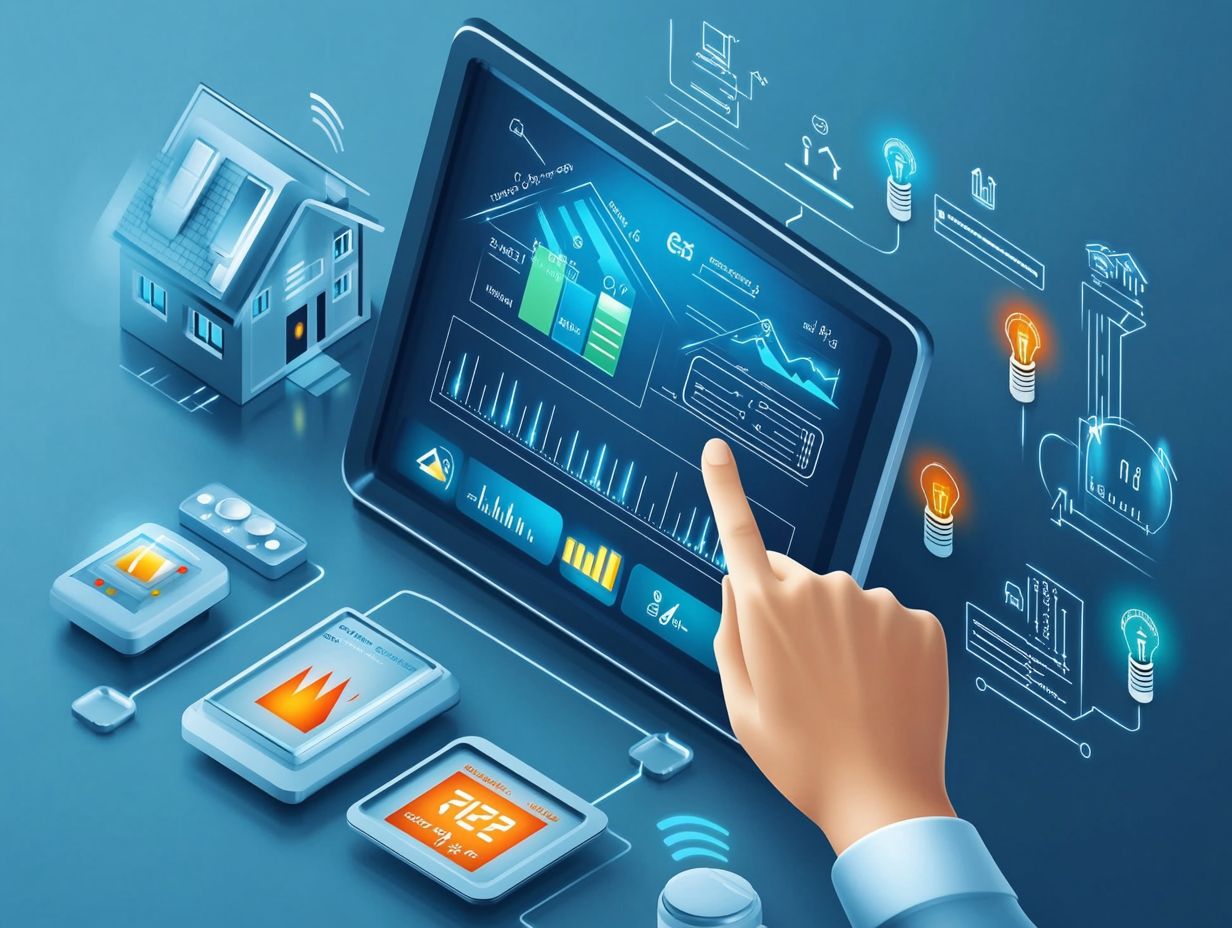
- Create a schedule: Set up a schedule for your smart devices to turn on and off at certain times, optimizing energy usage and reducing waste.
- Utilize energy management systems: These systems can automatically adjust your energy usage based on the time of day, occupancy, and outdoor weather conditions.
- Use energy dashboards: Energy dashboards provide real-time data on your energy consumption, allowing you to make informed decisions about your usage habits.
- Connect all devices to one central hub: By connecting all your smart devices to one central hub, you can easily manage and control your energy usage from one place.
- Set up alerts: Receive notifications when your energy usage exceeds a certain threshold, helping you stay conscious of your energy consumption.
- Consider renewable energy sources: Installing solar panels or a wind turbine allows you to generate your own clean energy, reducing reliance on traditional power sources.
In conclusion, adopting a smart home energy management system not only enhances your energy efficiency but also empowers you to make informed decisions. Start implementing these best practices today to maximize your investment in smart technology!
Are there any safety precautions I should take when using smart home energy management?
1. Always use certified devices: Purchase devices that are certified and meet safety standards.
2. Secure your network: Protect your smart home network from hackers by using strong passwords and regularly updating your router’s firmware.
3. Monitor data privacy: Be aware of what data your smart devices collect and share. Adjust privacy settings as needed.
4. Keep devices away from water: Avoid using smart devices near water sources or in areas where they might get wet.
5. Regularly update software: Keep your devices’ software up to date to ensure security and proper functionality.
6. Use devices that protect against power spikes: Install surge protectors to shield your devices from power surges.
Can smart home energy management help me save money?
Yes! Using smart home energy management practices can reduce your energy bills. Energy-efficient devices, scheduled usage, and monitoring consumption help you save money over time.
How do I get started with smart home energy management?
1. Research and choose compatible devices: Start by selecting devices that work with your home and energy management system.
2. Set up a central hub: A central hub connects all your smart devices for easier control.
3. Create a plan: Outline your energy management strategy based on your habits and preferences.
4. Install and connect devices: Follow the manufacturer’s instructions for installation.
5. Monitor and adjust: Track your energy usage and make adjustments to optimize your system.
6. Seek professional help: If you’re unsure about setup, consider getting professional assistance for proper installation.
Can smart home energy management benefit the environment?
Yes! Implementing smart home energy management practices reduces energy consumption and carbon emissions. By using renewable energy sources and cutting down on waste, we can lower our carbon footprint and contribute to a cleaner, more sustainable planet.
Start researching smart devices today and take your first step toward energy savings!

